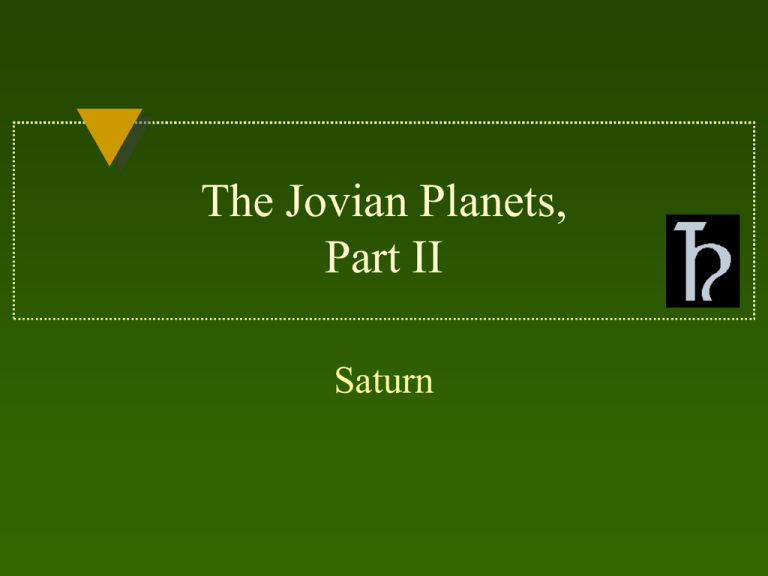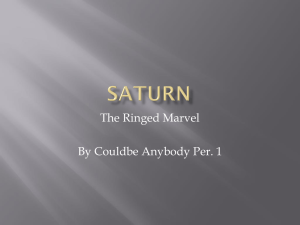The Jovian Planets, Part II Saturn
advertisement

The Jovian Planets, Part II Saturn SATURN The God of Agriculture Physical Data Diameter: 119,871 km (9.41 Dearth) Mass: 5.69x1029 g (95.1 Mearth) Density: 0.70 g/cm3 (lighter than water!) Rotation Period: 10.66 hours o Tilt of Axis: 26.7 o Surface Temperature: 103 K (-274 F) Physical Data Orbital Semi-Major Axis: 9.54 AU Orbital Period: 29.46 years o Orbital Inclination: 2.5 Orbital Eccentricity: 0.056 Surface Gravity: 1.17 Earth gravity Satellites: 60 as of 2011 Magnetic Field: yes Saturn’s Interior ATMOSPHERE Outer three layers are similar to Jupiter’s The exact composition of the core of Saturn is still unknown LIQUID MOLECULAR HYDROGEN METALLIC HYDROGEN ICE? ROCK? Saturn’s Atmosphere 94% Hydrogen 6% Helium Small amounts of: Methane Ammonia Phosphine Ethane Acetylene Saturn’s Atmosphere CLOUDS: Composed of methane and ammonia Saturn is surrounded by an orange haze which masks the cloud -top features Saturns belts are therefore less noticeable False color image shows Saturn’s bands Saturn’s Atmosphere WINDS: Unlike Jupiter, all go in the same direction (east) The equatorial jet reaches speeds of 1,100 mph! (Fastest winds on Jupiter are 335 mph) Saturn’s Atmosphere FEATURES: Ovals - cyclonic features like Great Red Spot on Jupiter They don’t last long Biggest ovals seen on Saturn are only 1/10 as big as the Great Red Spot The White Spot of 1994 Saturn’s Atmosphere Hot Surface Temperature: Like Jupiter, Saturn radiates 2.5x as much heat as it receives from the Sun Saturn is two times farther away from the Sun than Jupiter, and receives 1/4 as much sun light, so Saturn’s interior is less hot Saturn’s internal heat is due to heavy element diffusing toward the interior Saturn’s Magnetic Field Detected by Pioneer spacecraft Between the size of Earth and Jupiter’s magnetic field (0.5 Gauss) Magnetic axis is almost aligned with o rotation axis (0.7 tilt) Saturn’s Rotation Periods Differential rotator like Jupiter Rotation Period is 10h02m at equator o Rotation Period is 1 hour longer at 60 latitude Radio Period: 10h39m22s Spin so fast, Saturn is very oblate (flat) Saturn’s Ring System There is a gap between the A and B ring called “Cassini’s Division” Ring particles are made of mostly ice Average particle size is about 10 meters CASSINI’S DIVISION SATURN E G F A B C D Saturn’s Ring System Spokes: Magnetically levitated dust which is rotating with the magnetic field This dust is about the size of cigar smoke m Saturn’s Ring System Shepherd Satellites: Small moons in the rings gravitationally interact with wandering ring particles and return them to the ring, thus preserving the ring. Shepherd Satellites Prometheus and Pandora sheperding the F ring Saturn’s Moons A total of 18 have been discovered thus far Co-Orbital Satellites: As a trailing co-orbital satellite overtakes the leading satellite, they gravitational forces make the moons trade places 1 2 3 4 5 Saturn’s Moons TITAN: Saturn’s largest moon Only 2% smaller than Ganymede, so is the second largest moon in the solar system Has a thick nitrogen atmosphere Surface Pressure: 1.6 atm Saturn’s Moons MIMAS: Has an impact crater that is 1/3 the diameter of the satellite Biggest impact Mimas could have taken and still survived Saturn’s Moons PHEOBE: Discovered in 1898 First retrograde satellite known in the solar system Most likely a captured satellite Saturn’s outermost moon Saturn’s Moons Iapetus: Is sweeping dark dust from Pheobe Like most moon it is in synchronous rotation It’s leading face is therefore 5x dimmer than its trailing face Saturn’s Moons Hyperion: Only satellite in the solar system that is not in synchronous orbit Not spherical It is the sixteenth moon out and is 286 km in diameter



